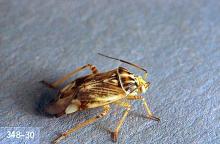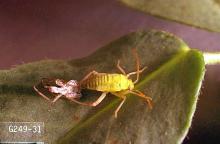Includes Lygus spp.
Pest description and crop damage Adults are 0.18 inch long and have a light yellow V on the back. Lygus bugs pierce buds and suck sap, injuring both vegetative and reproductive buds. Damage includes blasted buds, blossom drop, and shriveled seed.
Management-chemical control
First application-Apply insecticides on warm days in late May as populations approach three per sweep and appear to be increasing. Use at least 10 gal/A spray in aerial applications.
Second application-May need to reapply during bloom if lygus bugs (adults plus nymphs) reach three to four per 180° sweep of a 15-inch net but before most of the nymph field population reach fourth instar.
- Beauveria bassiana strain GHA (BotaniGard WP) at 0.11 to 0.44 lb ai/A in 100 gal. PHI 0 days. This product is potentially pathogenic to honeybees. Avoid applying to areas where honeybees are actively foraging or around beehives. Drift and runoff may be hazardous to aquatic organisms in water adjacent to treated areas. Typically, it takes 7-10 days after the first spray to see control. Apply at 5- to 10-day intervals for low to normal pest pressure. For high pest pressure, especially aphids, apply at 2- to 5-day intervals. Repeat applications for as long as pest pressure persists. There is no limit on the number of applications or total amount of product that can be applied in one season.
- carbaryl (Carbaryl 4L) at 1 to 1.5 lb ai/A. REI 12 hr. On dense growth, apply in 25 to 40 gallons of water per acre with ground equipment to ensure adequate coverage. Extremely toxic to aquatic invertebrates and bees. Notify beekeepers within 1 mile of treatment area. PHI 7 days. Do not exceed 1.5 qts. per acre per cutting. It may cause temporary bleaching of tender alfalfa foliage. Labeled for Idaho.
- dimethoate (400EC, Dimate 4E) at 0.25 to 0.5 lb ai/A. PHI 10 days. REI 48 hr. For suppression only. Do not apply if crop or weeds are in bloom. Effective only on cutting to which chemical is applied. Do not feed or graze livestock. Do not apply more than once per cutting cycle and more than three times per year. Minimum retreatment intervals of 30 days.
- Isaria fumosorosea Apopka strain 97 (ANCORA) at 14 to 28 oz ai/100 gal water. Repeat applications at 3- to 10-day intervals over 2 to 3 weeks or as needed to maintain control. Formerly Paecilomyces fumosoroseus. More frequent application at low rates (e.g., 14 to 16 oz/100 gal every 3 to 5 days) is more likely to improve results than using higher rates at low frequency (e.g., 28 oz/100 gal every 10 days). ID EPA Reg. No. 70051-19-59807.
- gamma-cyhalothrin (Declare) at 0.01 to 0.015 lb ai/A. PHI 1 day for forage and 7 days for hay. REI 24 hr. Minimum 2 gal/A by air or 10 gal/A by ground. Remove bee shelters during and for 2 to 3 days following application. Do not apply more than 0.015 lb ai/A per cutting or more than 0.06 lb ai/A per season.
- flonicamid (Beleaf) at 0.0875 lb ai/A. PHI not given on label. REI 12 hr. This product will also suppress aphids. Do not apply more than 2 applications at this rate closer than 7 days apart per crop year. 30-day plant back restriction. SLN OR-070023; ID 070014; WA-070013b; NV-070007; UT-07-0007; WY-080009.
- formetanate hydrochloride (Carzol SP) at 0.46 to 0.92 lb ai/A. PHI 21 days. REI 4 days. Do not apply during bloom and do not exceed 0.92 lb ai/A per season. Do not use any crop part as feed. Treated fields must be cleared after harvest by burning or disking.
- gamma-cyhalothrin (Proaxis, Declare) at 0.01 to 0.015 lb ai/A. PHI 1 day for forage, 7 days for hay. REI 24 hr. Do not exceed 0.06 lb ai/A per season or 0.015 lb ai/A per cutting. Do not apply on ground within 25 ft of aquatic habitat, 150 ft if applied by air or 450 ft if applied from ULV.
- lambda-cyhalothrin (Serpent 1EC, Warrior II) at 0.02 to 0.03 lb ai/A. PHI 1 day for forage, 7 days for hay. REI 24 hr. Do not apply more than 0.03 lb ai (3.84 fl oz or 0.24 pint of product) per acre per cutting, or more than 0.12 lb ai (15.36 fl oz or 0.96 pint of product) per acre per season. Do not apply on ground within 25 ft of aquatic habitat (groundboom, overhead chemigation, or airblast), 150 ft if applied by air, or 450 ft if applied from ULV. Do not apply while bees are active. Advisable to move bee shelters for 2 to 3 days after application. Avoid application when bees are actively foraging by applying during the early morning or during the evening hours.
- lambda-cyhalothrin + chlorantraniliprole (Besiege) at 0.03-0.06 lb ai/A. PHI 1 day for forage and 7 days for hay. Do not exceed a total of 31.0 fl oz per year. Do not apply more than 10.0 fl oz per acre per cutting and no more than 1 application per cutting. Avoid application when bees are actively foraging by applying during the early morning or during the evening hours. It may be advisable to remove bee shelters during and for 2 to 3 days following application. Avoid direct application to bee shelters.
- naled (Dibrom 8E) 1.0 to 1.5 lb ai/A. PHI not given. REI 48 hr for 1 lb ai/A or less, 72 hr for rates greater than 1 lb ai/A. Allow at least 7 days between applications. Do not apply during bloom nor exceed three applications per season. No part of treated field may be used as feed. SLN ID-010017; OR-990032; WA-990028.
- permethrin at 0.1 to 0.2 lb ai/A. PHI 0 days at rates equal to or less than 0.1 lb ai/A, 30 days at rates greater than 0.1 lb ai/A. REI 12 hr. Do not reapply at less than 7-day intervals or exceed 0.2 lb ai/A per cutting. If used during bloom, remove bees from field for 3 days. Do not apply on ground within 25 ft of aquatic habitat, 100 ft if applied by air, or 450 ft if applied from ULV.
- zeta-cypermethrin (Mustang Max) at 0.014 to 0.025 lb ai/A. PHI 3 days for cutting or grazing, 7 days for harvest. REI 12 hr. Allow at least 7 days between applications. Do not exceed 0.05 lb ai/A per cutting or 0.15 lb ai/A per year. Do not apply on ground within 25 ft of aquatic habitat, 150 ft if applied by air, or 450 ft if applied from ULV.
Resistance management Growers are advised strongly to rotate insecticide families (i.e., organophosphates, carbamates, and synthetic pyrethroids) in their lygus control programs to help prevent developing insecticide resistance.



